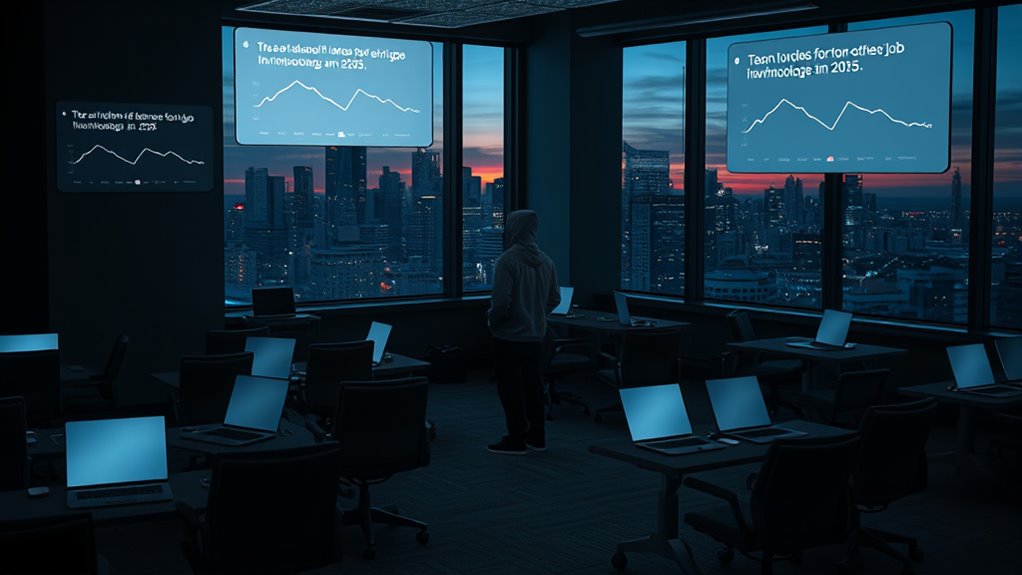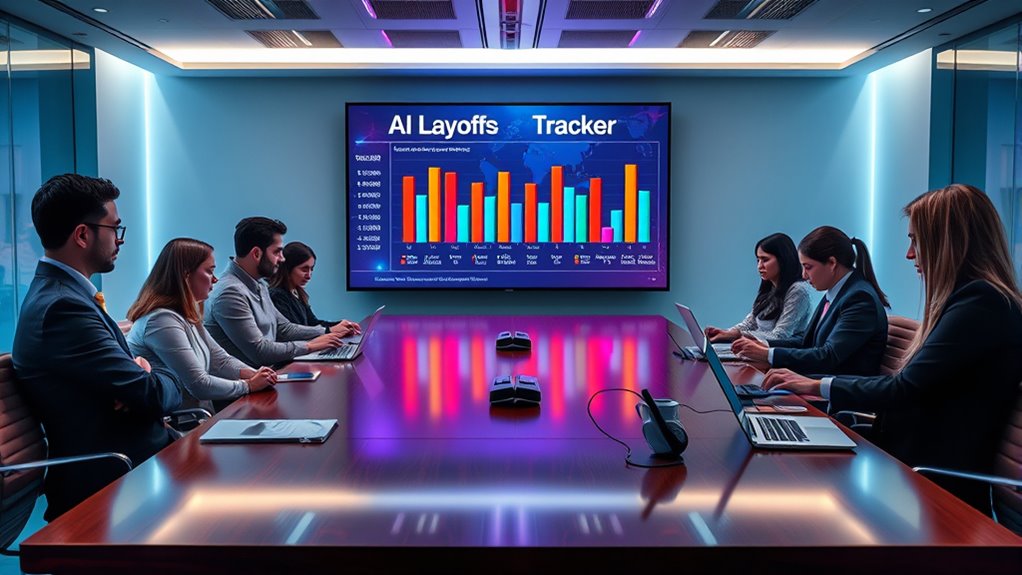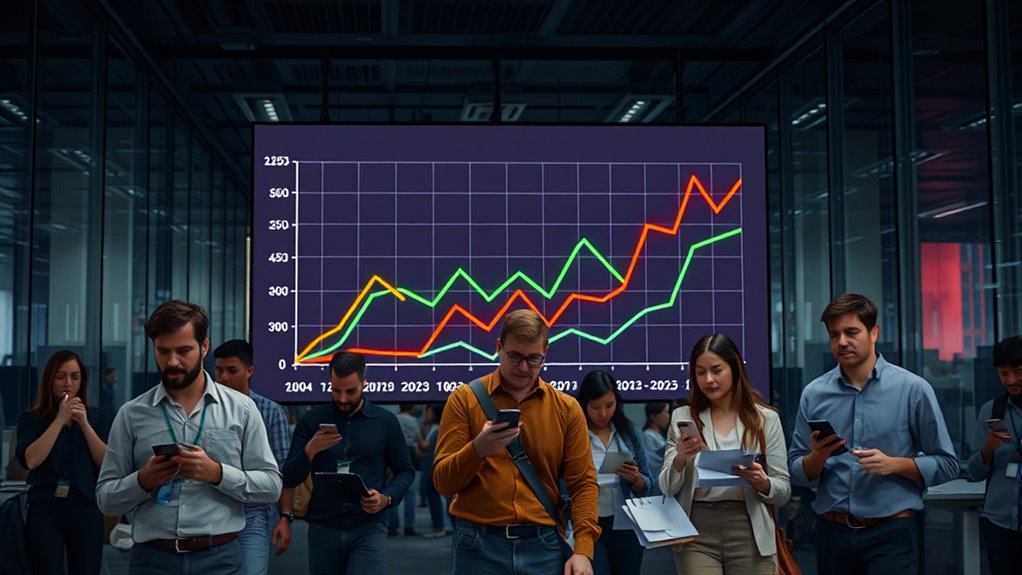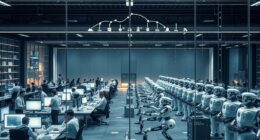In 2025, AI-driven layoffs have reshaped the tech industry, with over 94,000 jobs lost across startups and giants like Microsoft, Google, and Meta. Automation replaced roles across sectors, demanding new skills and resilience. Companies are focusing on upskilling workers to stay competitive, while economic disparities deepen. Staying informed can help you understand how this shift impacts your career and future opportunities—continue exploring to uncover more insights.
Key Takeaways
- Major tech companies like Microsoft, Google, Meta, and IBM have collectively laid off over 94,000 workers in 2025 due to AI automation.
- AI-driven layoffs primarily target routine and white-collar roles, emphasizing the need for continuous reskilling and skill adaptation.
- Workforce restructuring includes significant investments in AI infrastructure, with companies reallocating budgets from traditional roles to AI R&D.
- The layoffs contribute to economic inequality, with displaced workers facing challenges, highlighting the societal impact of AI-driven industry shifts.
- Resilience strategies include embracing AI, fostering lifelong learning, and developing both technical and soft skills to stay competitive.
The Scale of 2025 Tech Workforce Reductions

In 2025, the tech industry has experienced a significant wave of workforce reductions, with over 22,000 jobs cut so far. This wave peaked in February, with more than 16,000 layoffs in a single month, highlighting the sector’s ongoing restructuring. Major companies like Microsoft, Google, and Meta have led the cuts, with Microsoft alone laying off nearly 15,000 employees across May and July. Despite a resilient job market elsewhere, these layoffs stand out as a notable trend in tech, reflecting strategic shifts rather than economic distress. Overall, nearly 94,000 tech jobs have vanished this year, signaling a fundamental change in how companies operate. These reductions are not isolated but part of a broader industry transformation driven by automation and AI investments. Industry-wide layoffs continue to shape the landscape, emphasizing the importance of technological evolution and adaptability in today’s tech environment.
How AI Became the Main Catalyst for Job Losses

AI rapidly automates routine tasks, making many entry-level jobs obsolete overnight. Companies redirect their budgets toward AI tools, prioritizing cost savings over human workers. These strategic shifts lead to widespread layoffs, reshaping the job market faster than ever before.
Automation Replaces Routine Tasks
Automation has become the primary driver behind widespread job losses as artificial intelligence increasingly handles routine tasks across industries. In 2025 alone, nearly 78,000 tech jobs were lost due to AI, with companies like Microsoft, IBM, Meta, and Amazon citing automation as a key factor. Routine tasks in HR, software engineering, and device operations are now automated, leading to large-scale layoffs—30% of U.S. companies have replaced workers with AI tools like ChatGPT. Many firms are automating rather than augmenting, especially roles involving repetitive, process-driven work. This trend is spreading beyond tech to sectors like retail, healthcare, and finance. Historically, automation displaced millions of manufacturing jobs; now, white-collar roles are also at risk, fundamentally transforming the labor landscape. Additionally, home improvement strategies such as decluttering and organization can help workers adapt to changing environments by boosting productivity and mental clarity.
AI Redirects Budgets Fast
Major tech companies are rapidly shifting their budgets to prioritize artificial intelligence over traditional roles, substantially impacting workforce structures. In 2025, firms like Microsoft, Google, Amazon, Meta, and Intel have laid off over 60,000 workers in the first half alone, redirecting funds toward AI research, engineering, and infrastructure. These strategic layoffs aim to reallocate resources from routine and middle-tier roles to AI development, often offering top AI talent salaries exceeding $280,000 annually. Budget shifts favor AI innovation over maintaining existing workforce levels, especially in middle management and support functions. This aggressive reallocation fuels a transformation where traditional roles diminish, replaced by demand for data scientists, AI specialists, and machine learning engineers, positioning AI as the central driver of corporate restructuring and long-term competitiveness. Over 150,000 tech workers have been laid off since 2023, highlighting the scale of this industry-wide shift.
Strategic Shifts Drive Layoffs
As companies increasingly prioritize technological innovation, strategic shifts have made AI the primary driver behind widespread job reductions. With 90% of US firms adopting AI and 30% replacing workers, AI’s influence is undeniable. From January to June 2025, nearly 78,000 tech jobs disappeared due to AI, with many firms automating tasks instead of augmenting human roles. Major players like Microsoft, IBM, and Amazon are leading layoffs, reallocating resources to AI development. These shifts aren’t just cutting jobs—they’re transforming industries, with AI replacing routine and administrative functions. Companies are using layoffs to fund AI infrastructure, fueling market competition and lowering wages. Industry-Wide Layoffs and Motivations While short-term job losses are evident, these strategic moves aim to position businesses for future growth in an AI-driven economy. Additionally, the rapid adoption of AI emphasizes the importance of understanding technological trends that are reshaping employment landscapes.
Key Companies Leading the Layoff Surge

You’ll notice that major tech giants like Scale AI, Microsoft, and Meta are driving the recent surge in layoffs, often tied to AI integration. Rising startups are also making cuts, replacing roles with automation to stay competitive. These companies highlight how AI is reshaping workforce size across industries at an accelerated pace. Recent industry trends show a broader shift toward prioritizing AI infrastructure over human resources, leading to significant workforce reductions. Additionally, retail hours today reflect how operational adjustments are part of the wider economic shifts impacting employment strategies.
Major Tech Giants
Leading the surge in tech layoffs are some of the industry’s biggest players, each prioritizing AI-driven transformation over traditional growth strategies. Microsoft has laid off thousands as it shifts focus to AI and automation, with AI now writing up to 30% of its code. Meta mirrors this approach with significant job cuts aligned with AI initiatives. Google, while less highlighted, also participates in industry-wide layoffs. IBM has cut roles in HR and routine areas, replacing jobs with AI tools. PwC, too, has made notable layoffs without specific tech role details. Overall, nearly 94,000 tech workers have lost jobs by mid-2025, driven by AI’s role in automating tasks and reallocating resources. These giants are reshaping their workforces to focus on AI infrastructure and talent, signaling a permanent industry shift. Ethical Hacking techniques are increasingly utilized to secure these AI systems against cyber threats, highlighting the importance of cybersecurity in the evolving industry landscape.
Rising Startup Cuts
Startups are driving a significant portion of the 2025 tech layoffs, reflecting a broader industry shift toward AI-driven efficiency. Over 150,000 layoffs occurred in 2024, with more than 22,000 in the first half of 2025, many from startups. These cuts often stem from strategic pivots toward AI and automation, with companies like Rec Room reducing headcount by 16%, focusing on AI improvements. Some startups, such as ANS Commerce, have been fully shut down after acquisitions to realign AI strategies. Many are reallocating budgets from traditional roles to AI R&D, resulting in rapid workforce restructuring. The ongoing surge, reported by layoff tracking platforms, shows no signs of slowing, highlighting how startups prioritize agility and cost-cutting amid fierce AI competition. Understanding the implications of asset division and custody arrangements is crucial for navigating startup layoffs that impact team structures and equity distribution.
Sectoral Impact: From Startups to Industry Giants

The impact of AI-driven layoffs spans from small startups to industry giants, reshaping the entire tech landscape. Over 94,000 tech jobs have vanished in 2025, driven by AI automation and restructuring efforts. Startups are forming partnerships that lead to smaller teams, cutting jobs to align with AI strategies and secure funding. They face challenges integrating AI, which hampers growth. Meanwhile, industry giants like Microsoft and Intel are also laying off workers to invest in AI research and infrastructure, restructuring their workforces for the future. Major companies are redirecting investments toward AI, positioning themselves for long-term success. The wave of layoffs, especially in February, highlights a sector-wide shift, emphasizing the need for adaptation amidst rapid technological change. Meta’s recent restructuring to focus on AI is another example of how major players are realigning their workforce to capitalize on AI opportunities. Additionally, the ongoing technological and economic shifts driven by AI advancements are prompting firms to rethink their workforce strategies to stay competitive.
Skills at Risk: Preparing for an AI-Driven Job Market

As AI continues to transform the job market, developing the right skills becomes essential for staying competitive. You need to focus on technical and digital skills, as over half of entry-level jobs now demand them. AI and data analysis proficiency are key for career growth, especially in multidisciplinary roles combining business and tech. Soft skills like communication and critical thinking remain crucial, while continuous learning helps you adapt to new tools and trends. Staying informed about low carb foods and dietary strategies can also foster a mindset of ongoing self-improvement and adaptability.
The Strategic Shift: Redirecting Resources Toward AI

Companies are shifting their focus and reallocating resources toward AI to stay competitive in a rapidly evolving market. You’ll see major players like Meta planning to invest up to $65 billion in AI projects by 2025, signaling a strategic pivot. CapEx on AI stabilizes after rapid growth, with firms prioritizing current projects over new expansions. Big Tech closely monitors each other’s investments, fostering an oligopolistic environment. Falling compute prices from new data centers make AI more accessible, encouraging startups and innovation. As a result, cost reductions are fueling broader adoption and experimentation across industries. Strategic partnerships, such as Oracle and OpenAI’s Stargate project, further accelerate AI capabilities. As resources pivot to AI, traditional roles are phased out, and budgets are reallocated toward research and engineering, reflecting a clear industry-wide drive to harness AI’s transformative potential. This massive infrastructure expansion has further lowered AI compute costs, enabling more widespread adoption and experimentation.
Broader Economic Impacts and Workforce Displacement

As AI-driven layoffs increase, you might notice growing economic inequality, with displaced workers struggling to find new roles. Long-term, these shifts could deepen workforce divides and widen income gaps. Understanding these impacts helps you see how AI reshapes not just jobs but the economy as a whole.
Economic Inequality Rise
The rise in economic inequality is reshaping societies worldwide, leading to broader economic impacts and significant workforce displacement. You’ll notice more communities trapped in persistent poverty, especially in areas like Appalachia and the Mississippi Delta, while over a third of the global population lives on just a few dollars a day, heightening vulnerability. In the U.S., income gaps remain stark—top earners make at least $4.61 for every dollar of the bottom 20%, and racial disparities persist, with median Black and Latino workers earning considerably less than white workers. This growing inequality erodes trust in institutions, strains social bonds, and fuels dissatisfaction. As inequality widens, it threatens the social contract, complicates economic growth, and makes workforce displacement more pronounced, especially for marginalized groups facing higher unemployment and lower wages. Madison, WI experienced the largest increase in income inequality, highlighting how disparities can intensify rapidly within specific communities. Moreover, the widening gap between different socioeconomic groups can hinder overall economic resilience and innovation.
Long-term Workforce Changes
Long-term workforce changes driven by AI are reshaping economic stability and job opportunities worldwide. You’ll notice about 85 million jobs globally might disappear by 2025, mainly in manufacturing and retail. In the U.S., nearly 40% of employers expect to cut jobs due to automation, with tech giants losing nearly 78,000 jobs this year alone. Around 13.7% of workers feel they’ve already lost jobs to AI or robots. White-collar roles are also changing; AI now handles 30–50% of tasks in large firms, often lowering salaries. Entry-level jobs, especially for young workers, are shrinking, making it harder to get started. These shifts widen regional gaps and threaten long-term employment prospects, especially for early-career workers, pushing the economy toward increased instability and inequality. Automation barriers may delay full adoption, prolonging economic disruption and the transition period for workers.
Tracking and Data Sources: Measuring the Layoff Trends
Tracking and measuring layoff trends in the AI-driven era relies on a variety of data sources that compile real-time and historical information. You can access all-encompassing lists from TechCrunch, which breaks down layoffs by month and company, revealing the significant impact of AI strategies. Platforms like Layoffs.fyi and Intellizence Insights gather data from public reports, WARN filings, and media coverage, offering detailed industry-specific insights. Sector trackers, such as Fierce Biotech, help monitor layoffs across different fields. These sources update regularly, providing accurate, up-to-date figures—over 94,000 tech workers laid off in 2025, with a notable spike in February. By combining these tools, you gain a clear picture of how AI transformation influences workforce shifts across industries. Additionally, many of these platforms incorporate data on AI-related layoffs, helping to identify trends directly linked to technological advancements.
Lessons Learned From the Largest 2025 Tech Cuts

Analyzing the largest tech layoffs of 2025 reveals valuable lessons about industry shifts and strategic priorities. You see, companies are redirecting resources toward AI and automation, which profoundly impacts employment. Microsoft’s massive layoffs, including nearly 15,000 job cuts, reflect a focus on restructuring around AI investments—like their $80 billion commitment to AI infrastructure. The move toward AI-driven efficiencies means roles are changing, with AI now generating 20-30% of code at firms like Microsoft. This shift highlights the importance of adapting skillsets and preparing for new workforce demands. It also emphasizes that competitiveness now hinges on innovation and technological agility. Ultimately, these layoffs teach you that embracing AI and restructuring for efficiency are essential for staying relevant in a rapidly evolving industry landscape. AI-driven efficiencies are accelerating the need for employees to develop new technical skills to remain valuable in this transformation.

As AI continues to transform the workplace, you must proactively adapt through reskilling and upskilling efforts. Nearly 77% of businesses in 2025 prioritize these initiatives to prepare workers for collaboration with AI. Focus on developing both technical skills, like AI literacy, and soft skills such as communication. Use online courses, night classes, or company-sponsored programs to stay current. Upskilling boosts your productivity, helps retain your job, and facilitates smoother AI integration. Embrace lifelong learning to remain competitive in this fast-changing environment. Additionally, be open to changing roles or careers that align better with AI advancements. Developing cross-functional skills and staying adaptable will empower you to navigate future work landscapes confidently, ensuring your relevance and growth amid ongoing technological shifts.
Frequently Asked Questions
How Accurate Are the Current Layoff Figures Compared to Actual Job Losses?
You might wonder how accurate the current layoff figures are compared to actual job losses. The truth is, these numbers can vary due to sources, company disclosures, and reporting delays. While trackers like Layoffs.fyi provide valuable insights, they may not capture every layoffs detail. So, stay cautious—figures are estimates that can sometimes miss the full scope, especially with AI-driven changes influencing job stability.
What Are the Long-Term Implications of Ai-Driven Layoffs on Innovation?
You might worry that AI-driven layoffs could stifle innovation long-term. While cost-cutting and automation boost short-term efficiency, they risk narrowing focus to AI-centric areas, potentially slowing breakthroughs outside these domains. As talent concentrates in AI and funding follows, other fields may stagnate. Over-reliance on AI for efficiency could reduce diverse perspectives, limiting creativity and delaying new ideas beyond AI, ultimately hindering broader technological progress.
How Are Policymakers Responding to the Surge in Ai-Related Employment Disruptions?
Imagine policymakers stepping into the storm, trying to steer the ship of the economy through turbulent AI layoffs. You see them crafting new rules, funding reskilling programs, and shaping laws to buffer workers from the fallout. They’re actively responding, like skilled pilots, guiding society toward stability amid upheaval. Their goal: balance innovation’s rush with protections for those caught in the crossfire, ensuring the future remains fair and resilient.
Which Skills Are Most Critical for Workers to Remain Relevant in an Ai-Heavy Industry?
You need to focus on developing both technical and human-centered skills to stay relevant in an AI-heavy industry. Strengthen your programming, data analysis, and cybersecurity knowledge, while honing communication, critical thinking, and adaptability. Embrace lifelong learning and stay updated on ethical, regulatory, and domain-specific insights. By combining technical expertise with soft skills like collaboration and creativity, you’ll be better prepared to navigate rapid AI advancements and emerging workplace challenges.
Will AI Layoffs Lead to Increased Economic Inequality Across Regions?
You might worry that AI layoffs will widen economic inequality across regions. This is likely because areas with better access to education, technology, and retraining programs will adapt more quickly, creating a gap. Conversely, regions lacking these resources could face higher unemployment and economic struggles. To reduce disparities, you should support policies that promote equitable access to upskilling, infrastructure, and industry investment, helping all regions benefit from AI’s growth.
Conclusion
As you face an AI-driven job market, remember that over 30% of tech roles were cut in 2025 alone. This staggering number highlights the need to stay adaptable and continuously upgrade your skills. Embrace change as an opportunity, not a threat. With resilience and a proactive mindset, you can navigate the shifts ahead and turn challenges into new growth opportunities in an evolving workforce.









